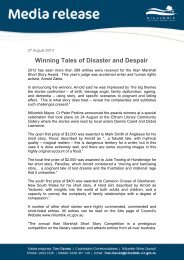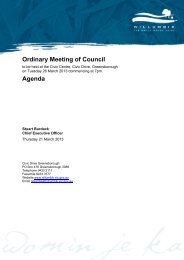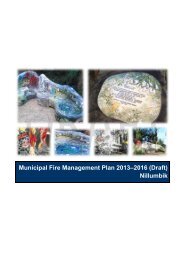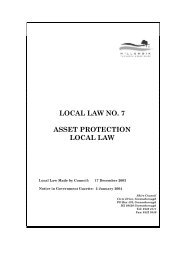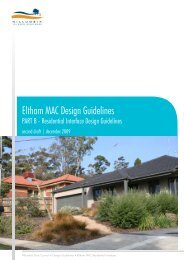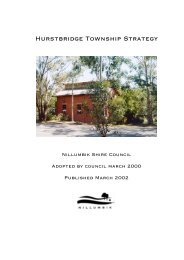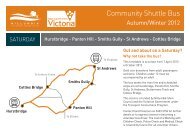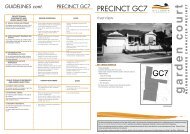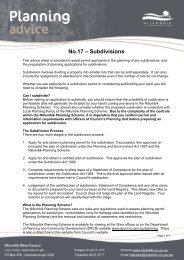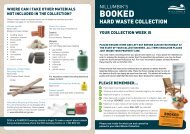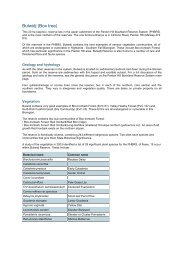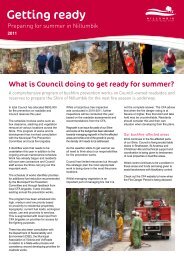Agenda of Policy and Services Committee Meeting - 12 March 2013
Agenda of Policy and Services Committee Meeting - 12 March 2013
Agenda of Policy and Services Committee Meeting - 12 March 2013
Create successful ePaper yourself
Turn your PDF publications into a flip-book with our unique Google optimized e-Paper software.
<strong>Policy</strong> <strong>and</strong> <strong>Services</strong> <strong>Committee</strong>to be held at the Civic Centre, Civic Drive, Greensboroughon Tuesday <strong>12</strong> <strong>March</strong> <strong>2013</strong> commencing at 7pm.<strong>Agenda</strong>Stuart BurdackChief Executive OfficerWednesday 6 <strong>March</strong> <strong>2013</strong>Distribution:PublicCivic Drive GreensboroughPO Box 476 Greensborough 3088Telephone 9433 3111Facsimile 9433 3777Website www.nillumbik.vic.gov.auEmail nillumbik@nillumbik.vic.gov.au
<strong>Policy</strong> <strong>and</strong> <strong>Services</strong> <strong>Committee</strong> seating planCr Michael YoungEDENDALE WARDCr Peter PerkinsELLIS WARDCr Anika Van HulsenBUNJIL WARDCr Bronnie HattamSUGARLOAF WARDCr Meralyn KleinBLUE LAKE WARDCr Ken KingSWIPERS GULLY WARDStuart BurdackChief ExecutiveOfficerCr Helen Coleman(Chairperson)WINGROVE WARDVisitors in the gallery at <strong>Committee</strong> meetings are:• Welcome to copies <strong>of</strong> the various reports which will be considered by this <strong>Committee</strong> at the meeting.These are on the table in the foyer.• Welcome to tea, c<strong>of</strong>fee <strong>and</strong> water. These are on the table in the foyer near the Council Chamber entry.• Requested to observe Council deliberations quietly in order for Council meetings to run smoothly.
<strong>Policy</strong> <strong>and</strong> <strong>Services</strong> <strong>Committee</strong> agenda <strong>12</strong> <strong>March</strong> <strong>2013</strong>Nillumbik Shire CouncilContents1. Welcome <strong>and</strong> apologies <strong>12</strong>. Disclosure <strong>of</strong> conflicts <strong>of</strong> interest 13. Confirmation <strong>of</strong> minutes 14. <strong>Policy</strong> <strong>and</strong> <strong>Services</strong> reports 2PS.005/13 Eltham Copper Butterfly Recovery 2PS.006/13 Panton Hill Bushl<strong>and</strong> Reserves System Management Plan 85. Supplementary <strong>and</strong> urgent business 176. Confidential reports 17
<strong>Policy</strong> <strong>and</strong> <strong>Services</strong> <strong>Committee</strong> agenda <strong>12</strong> <strong>March</strong> <strong>2013</strong>Nillumbik Shire Council<strong>Agenda</strong> <strong>of</strong> the <strong>Policy</strong> <strong>and</strong> <strong>Services</strong> <strong>Committee</strong> <strong>Meeting</strong> to be heldTuesday <strong>12</strong> <strong>March</strong> <strong>2013</strong> commencing at 7pm.1. Welcome <strong>and</strong> apologiesMotionThat the apologies be accepted.2. Disclosure <strong>of</strong> conflicts <strong>of</strong> interest<strong>Committee</strong> members should note that any disclosure <strong>of</strong> conflict <strong>of</strong> interest must bedisclosed immediately before the item in which they have an interest.3. Confirmation <strong>of</strong> minutesConfirmation <strong>of</strong> minutes <strong>of</strong> the <strong>Policy</strong> <strong>and</strong> <strong>Services</strong> <strong>Committee</strong> <strong>Meeting</strong> held onTuesday <strong>12</strong> February <strong>2013</strong>.MotionThat the minutes <strong>of</strong> the <strong>Policy</strong> <strong>and</strong> <strong>Services</strong> <strong>Committee</strong> <strong>Meeting</strong> held onTuesday <strong>12</strong> February <strong>2013</strong> be confirmed.1
<strong>Policy</strong> <strong>and</strong> <strong>Services</strong> <strong>Committee</strong> agenda <strong>12</strong> <strong>March</strong> <strong>2013</strong>4. <strong>Policy</strong> <strong>and</strong> <strong>Services</strong> reportsPS.005/13File: 20/35/086Distribution:Manager:Author:SummaryEltham Copper Butterfly RecoveryPublicConal Creedon, General Manager Infrastructure <strong>Services</strong>Corinne Mays, Coordinator Environmental WorksThe area around Eltham supports some <strong>of</strong> the last remaining populations <strong>of</strong> the threatenedEltham Copper Butterfly. Following the rediscovery <strong>of</strong> the butterfly in Eltham in 1987 thelocal community successfully lobbied <strong>and</strong> fundraised for the reservation <strong>of</strong> l<strong>and</strong> to supportbutterfly colonies <strong>and</strong> the species was listed as threatened under the Flora <strong>and</strong> FaunaGuarantee Act in May 1991.For the past 25 years there has been considerable investment <strong>of</strong> time <strong>and</strong> money tomaintain <strong>and</strong> conserve the butterfly populations through the efforts <strong>of</strong> l<strong>and</strong> managers,friends groups <strong>and</strong> the Eltham Copper Butterfly Working Group.The purpose <strong>of</strong> this report is to provide an overview <strong>of</strong> past <strong>and</strong> present efforts by thecommunity to protect <strong>and</strong> enhance the habitat <strong>of</strong> the Eltham Copper Butterfly as well asdiscussing opportunities for future community engagement <strong>and</strong> action.Background1. The area around Eltham supports the largest <strong>of</strong> the few remaining populations <strong>of</strong> thethreatened Eltham Copper Butterfly (ECB) in Victoria.2. Following the rediscovery <strong>of</strong> the ECB in the Eltham area in 1987, the ECB was listedas threatened under the Flora <strong>and</strong> Fauna Guarantee Act 1988 in May 1991.3. In the face <strong>of</strong> the then proposed urban development on Diosma Road in Eltham, thelocal community successfully lobbied <strong>and</strong> fundraised for the reservation <strong>of</strong> theWestern <strong>and</strong> Eastern ECB colonies <strong>and</strong> for the reservation <strong>of</strong> the Pauline TonerReserve, now owned by Parks Victoria.4. The early work undertaken by the local community to ensure the protection <strong>of</strong> theECB <strong>and</strong> its habitat is a remarkable story now very much embedded in the social,cultural <strong>and</strong> natural heritage <strong>and</strong> identity <strong>of</strong> the Eltham community.5. Over the past twenty-five years there have been sustained investments <strong>of</strong> time <strong>and</strong>money to maintain <strong>and</strong> conserve ECB populations <strong>and</strong> the supporting eco-system.This has been a cooperative effort <strong>of</strong> l<strong>and</strong> managers, Friends Groups, <strong>and</strong> the ECBWorking Group.6. Recent monitoring <strong>of</strong> ECB larvae suggests that populations <strong>of</strong> the butterfly haveplummeted to dangerously low levels.7. In 20<strong>12</strong>, the Friends <strong>of</strong> the ECB in partnership with Nillumbik Shire Council, ParksVictoria, the Friends <strong>of</strong> Diosma Road, the Friends <strong>of</strong> Woodridge Linear Reserve <strong>and</strong>Eltham East Primary School were successful in obtaining a grant from theDepartment <strong>of</strong> Sustainability <strong>and</strong> Environment <strong>of</strong> $459,000 over a four year period toundertake a range <strong>of</strong> works to protect <strong>and</strong> enhance the habitat <strong>of</strong> this significantspecies.2
<strong>Policy</strong> <strong>and</strong> <strong>Services</strong> <strong>Committee</strong> agenda <strong>12</strong> <strong>March</strong> <strong>2013</strong>4. <strong>Policy</strong> <strong>and</strong> <strong>Services</strong> reportsPS.005/13Eltham Copper Butterfly RecoveryEltham Copper Butterfly biology <strong>and</strong> distribution8. The ECB is a small <strong>and</strong> attractive butterfly with bright copper colouring on the tops <strong>of</strong>its wings which is visible during summer.9. It is an unusual species due to its close association with a group <strong>of</strong> ants from thegenus Notoncus <strong>and</strong> the shrub Sweet Bursaria (Bursaria spinosa).10. Adult butterflies lay their eggs on the roots <strong>and</strong> stems <strong>of</strong> Sweet Bursaria. Once theeggs hatch, the ants guard the caterpillars (providing protection from predators)ushering the larvae to <strong>and</strong> from the ant nest at the base <strong>of</strong> the shrub, to feed on theSweet Bursaria leaves at night. In return the ants feed on the sugar secretionsexuded from the body <strong>of</strong> the caterpillar.11. It is generally considered that the butterfly has a preference for open flight paths <strong>and</strong>receiving direct sunlight; namely vegetation with an open middle <strong>and</strong> under storey.<strong>12</strong>. The ECB is known only to occur in Victoria <strong>and</strong> has only been recorded at a fewlocations. These sites are in geographically separate areas <strong>and</strong> include:• Ten sites in the Eltham-Greensborough area including Pauline Toner Reserve<strong>and</strong> the Diosma Road reserves (Attachment 1).• Three separate small populations in the Kiata-Salisbury area in the Wimmera.• Three sites in the Bendigo region in rural Victoria.• Small populations at two sites at Castlemaine in rural Victoria13. In the Eltham area, Nillumbik Shire Council owns <strong>and</strong> manages six bushl<strong>and</strong>reserves for the conservation <strong>of</strong> the ECB. These reserves include:• Western Eltham Copper Butterfly Reserve• Eastern Eltham Copper Butterfly Reserve• Diosma Road Reserve• Woodridge Linear Reserve (Laleham Court)• Pitt Street Environmental Reserve• Hohnes Hill Environmental Reserve14. Parks Victoria owns <strong>and</strong> manages the Pauline Toner ECB Reserve in Eltham, <strong>and</strong>populations <strong>of</strong> the ECB occur on at least two known private properties in the Elthamarea.Decline <strong>of</strong> the ECB15. The ECB was listed as a threatened taxon in Schedule 2 <strong>of</strong> the Flora <strong>and</strong> FaunaGuarantee Act 1988 in 1991. The ECB is now classified as Endangered under theDSE Advisory List <strong>of</strong> Threatened Invertebrate Fauna in Victoria 2009.16. The major cause <strong>of</strong> decline <strong>of</strong> the butterfly across the State is the destruction <strong>and</strong>loss <strong>of</strong> habitat, the consequence largely <strong>of</strong> urbanisation <strong>and</strong> agricultural production.3
<strong>Policy</strong> <strong>and</strong> <strong>Services</strong> <strong>Committee</strong> agenda <strong>12</strong> <strong>March</strong> <strong>2013</strong>4. <strong>Policy</strong> <strong>and</strong> <strong>Services</strong> reportsPS.005/13Eltham Copper Butterfly Recovery17. The species has been eliminated over much <strong>of</strong> its former range <strong>and</strong> the remainingpopulations in the Eltham area are disparate <strong>and</strong> occur in small reserves across ahighly fragmented urban l<strong>and</strong>scape.18. Other factors relating to the urban environment <strong>and</strong> associated human activity whichfurther threaten the Eltham populations include weed invasion, rubbish dumping,trampling, slashing <strong>and</strong> clearing <strong>of</strong> vegetation <strong>and</strong> wildfires.19. Over the past seventeen years the Friends <strong>of</strong> the ECB in partnership with NillumbikShire Council <strong>and</strong> the ECB Working Group have been undertaking annual caterpillar<strong>and</strong> adult butterfly counts.20. The numbers fluctuate each year, but the 2011 <strong>and</strong> 20<strong>12</strong> counts indicate the largestdrop in numbers yet recorded. Table 1 below outlines ECB larvae survey data from2010.Colony 2009 2010 2011 20<strong>12</strong>Eastern ECB Reserve 150 87 17 17Western ECB Reserve 204 25 25 8Diosma Road Reserve 23 107 0 1421. It is suspected that increased rainfall over the last two years, <strong>and</strong> a prescribed burnundertaken in 1998, resulted in increased growth <strong>of</strong> both exotic <strong>and</strong> indigenousvegetation which have been at a detriment to the butterfly.22. However, in 20<strong>12</strong> a previously thought extinct population <strong>of</strong> ECB was rediscovered atWoodridge Linear Reserve at the Laleham Court entrance to the reserve. Monitoring<strong>of</strong> this site in 20<strong>12</strong> identified a total <strong>of</strong> 25 larvae.<strong>Policy</strong> context23. This report directly supports the achievement <strong>of</strong> Council Plan 2009-<strong>2013</strong> strategy: 2.1.11Support volunteer <strong>and</strong> community organisations to undertake environmentalprograms.Budget implications24. Much <strong>of</strong> the work that has been done to preserve the habitat for the Eltham CopperButterfly has been through the efforts <strong>of</strong> local community groups, in particular Friends<strong>of</strong> Diosma Road, Friends <strong>of</strong> Woodridge Linear Reserve <strong>and</strong> Friends <strong>of</strong> the ElthamCopper Butterfly.25. In 20<strong>12</strong> Friends <strong>of</strong> the Eltham Copper Butterfly in partnership with Council, ParksVictoria, Friends <strong>of</strong> Diosma Road, Friends <strong>of</strong> Woodridge Linear Reserve <strong>and</strong> theEltham East Primary School were successful in obtaining a Communities for NatureGrant from the Department <strong>of</strong> Sustainability <strong>and</strong> Environment <strong>of</strong> $459,000 to protect<strong>and</strong> enhance the habitat <strong>of</strong> the Eltham Copper Butterfly.4
<strong>Policy</strong> <strong>and</strong> <strong>Services</strong> <strong>Committee</strong> agenda <strong>12</strong> <strong>March</strong> <strong>2013</strong>4. <strong>Policy</strong> <strong>and</strong> <strong>Services</strong> reportsPS.005/13The conservation effortEltham Copper Butterfly Recovery26. In 2010 with support from Nillumbik Shire Council the Friends <strong>of</strong> the ECB, the Friends<strong>of</strong> Diosma Road <strong>and</strong> the Friends <strong>of</strong> Woodridge Linear Reserve received a jointcommunity grant from the Port Phillip & Westernport Catchment ManagementAuthority to develop <strong>and</strong> implement a community engagement program with theprimary aim <strong>of</strong> renewing local community support for the conservation <strong>of</strong> the butterfly<strong>and</strong> its habitat:27. Through this funding an extensive community engagement program was developed<strong>and</strong> implemented to increase awareness <strong>and</strong> appreciation <strong>of</strong> the conservation <strong>of</strong> theECB within the local Eltham community. The program also included capacity buildingactivities specifically developed to benefit the three friends <strong>of</strong> groups involved in theproject.28. In addition, weed infestations <strong>and</strong> garden encroachments into the reserves wereidentified <strong>and</strong> addressed as a main threat to the habitat <strong>of</strong> the ECB.29. In 20<strong>12</strong>, the Friends <strong>of</strong> the ECB in partnership with Nillumbik Shire Council, ParksVictoria, the Friends <strong>of</strong> Diosma Road, the Friends <strong>of</strong> Woodridge Linear Reserve <strong>and</strong>Eltham East Primary School (EEPS) were successful in obtaining a Communities forNature grant from the Department <strong>of</strong> Sustainability <strong>and</strong> Environment <strong>of</strong> $459,000 toprotect <strong>and</strong> enhance the habitat <strong>of</strong> the ECB.30. The objectives <strong>of</strong> this grant• Optimise the habitat requirements <strong>and</strong> conditions <strong>of</strong> the ECB across the tensites• Support sustainable populations <strong>of</strong> other rare <strong>and</strong> threatened species foundwithin the ECB sites as well the ECB itself• Increase the resilience <strong>of</strong> the ECB sites to weed invasion <strong>and</strong> other threats• Protect <strong>and</strong> enhance the ecosystem services (social, economic, cultural <strong>and</strong>heritage values) provided by the ECB sites• Coordinate weed control across property boundaries• Increase community participation <strong>and</strong> involvement in the protection <strong>of</strong> the ECB.Next steps31. Over the next four years the Communities for Nature grant will be implemented inpartnership with a range <strong>of</strong> stakeholders.32. A Project Governance <strong>Committee</strong> has been established to oversee theimplementation <strong>of</strong> the grant including representatives from the Friends Groups,EPPS, Nillumbik Shire Council, Parks Victoria, La Trobe University, Department <strong>of</strong>Primary Industries <strong>and</strong> Ecological Heritage Partners.33. The implementation <strong>of</strong> the grant involves several different aspects including, ongroundconservation works, monitoring <strong>of</strong> on-ground works <strong>and</strong> ECB populations,<strong>and</strong> the education <strong>and</strong> engagement <strong>of</strong> the community.5
<strong>Policy</strong> <strong>and</strong> <strong>Services</strong> <strong>Committee</strong> agenda <strong>12</strong> <strong>March</strong> <strong>2013</strong>4. <strong>Policy</strong> <strong>and</strong> <strong>Services</strong> reportsPS.005/13Eltham Copper Butterfly Recovery34. On-ground conservation works will involve weed control, ecological thinning <strong>of</strong>indigenous shrub species, revegetation <strong>and</strong> trials <strong>of</strong> coppicing Sweet Bursaria toencourage dwarf forms <strong>of</strong> the species which is the food source for the ECB larvae.35. While ECB populations have been monitored over an extended time frame, theinformation gathered will be collated, interpreted <strong>and</strong> integrated into the management<strong>of</strong> sites.36. Changes to current management practices will also be monitored to determine theimpact on significant species, especially the butterfly.37. In addition, residents directly adjoining the reserves, <strong>and</strong> the broader Eltham <strong>and</strong>Nillumbik communities will be engaged <strong>and</strong> encouraged to become involved in theconservation <strong>of</strong> the ECB.38. This flagship species can be used to engage <strong>and</strong> inspire people to take action <strong>and</strong>protect their local environment. The tools that will be used to increase awareness <strong>and</strong>engage the community include:• A facilitated network <strong>of</strong> residents will be established to support the conservation<strong>of</strong> the ECB.• An annual ECB day/event to be run in partnership with EEPS.• Production <strong>of</strong> interpretive signage at EEPS.• Production <strong>of</strong> a range <strong>of</strong> communication tools <strong>and</strong> materials such as posters,picture books <strong>and</strong> websites.Conclusion39. The Eltham Copper Butterfly is a threatened species listed under the Flora <strong>and</strong>Fauna Guarantee Act.40. There are 10 sites in the Eltham/Greensborough area in the Shire <strong>of</strong> Nillumbik whichsupport colonies <strong>of</strong> the Eltham Copper Butterfly.41. Management <strong>and</strong> preservation <strong>of</strong> the butterfly’s habitat requires ongoing effort <strong>and</strong>has recently been boosted by the receipt <strong>of</strong> a grant to Friends <strong>of</strong> the Eltham CopperButterfly to support these efforts.RecommendationThat the <strong>Committee</strong> (acting under delegation from Council):1. Notes the history <strong>of</strong> Council <strong>and</strong> community efforts to maintain <strong>and</strong> conserveEltham Copper Butterfly populations.2. Notes the continuing threats to the butterfly’s habitat <strong>and</strong> survival <strong>and</strong> thecurrent steps in place to manage <strong>and</strong> improve the habitat for the butterflycolonies in Nillumbik.Attachments1. Map <strong>of</strong> Eltham Copper Butterfly project locations, 1 page6
PS.005/13 Eltham Copper Butterfly RecoveryAttachment, 1 page7
<strong>Policy</strong> <strong>and</strong> <strong>Services</strong> <strong>Committee</strong> agenda <strong>12</strong> <strong>March</strong> <strong>2013</strong>4. <strong>Policy</strong> <strong>and</strong> <strong>Services</strong> reportsPS.006/13 Panton Hill Bushl<strong>and</strong> Reserves System Management PlanFile: 80/38/048Distribution: PublicManager: Conal Creedon, General Manager Infrastructure <strong>Services</strong>Author: Corinne Mays, Coordinator Environmental WorksSummaryNillumbik Council owns <strong>and</strong> manages seven reserves in the Panton Hill, Smiths Gully <strong>and</strong>Watsons Creek area collectively known as the Panton Hill Bushl<strong>and</strong> Reserve System(PHBRS). The reserves total approximately 140 acres in area <strong>and</strong>, in conjunction with l<strong>and</strong>managed by Parks Victoria <strong>and</strong> Crown L<strong>and</strong>, form a corridor <strong>of</strong> relatively intact remnantbushl<strong>and</strong> from Smiths Gully to Watsons Creek.Council adopted the Panton Hill Bushl<strong>and</strong> Reserves System Management Plan in June2011 as the key document to manage the important conservation, social <strong>and</strong> recreationvalues <strong>of</strong> the reserves. Implementation <strong>of</strong> the plan included the establishment <strong>of</strong> thePanton Hill Bushl<strong>and</strong> Reserves System User Group.The purpose <strong>of</strong> this report is to provide an overview <strong>of</strong> the Panton Hill Bushl<strong>and</strong> Reservesmanagement as well as an update on the implementation <strong>of</strong> the Reserves ManagementPlan.Background1. Nillumbik Shire Council owns <strong>and</strong> manages seven reserves in the Panton Hill, SmithsGully <strong>and</strong> Watsons Creek area collectively known as the Panton Hill Bushl<strong>and</strong>Reserve System (PHBRS).2. The reserves total approximately 140 hectares in area <strong>and</strong> as a system <strong>of</strong> reserves,in association with Parks Victoria Reserves <strong>and</strong> Crown L<strong>and</strong>, form a corridor <strong>of</strong>relatively intact remnant bushl<strong>and</strong> that extends from Smiths Gully in the North toWatson’s Creek in the south, primarily adjoining Long Gully Creek.3. The reserves are significant for their diverse array <strong>of</strong> native plants, animals <strong>and</strong>vegetation communities, important regional habitat links, the presence <strong>of</strong> threatenedspecies, the presence <strong>of</strong> historical <strong>and</strong> heritage sites, <strong>and</strong> opportunities forenvironmental education <strong>and</strong> recreation.4. Following an extensive period <strong>of</strong> community consultation spanning six years, Counciladopted the Panton Hill Bushl<strong>and</strong> Reserves System Management Plan in June 2011as the key document to manage the important conservation, social <strong>and</strong> recreationvalues <strong>of</strong> the reserves.5. In addition to the adoption <strong>of</strong> the plan, Council’s 2011-20<strong>12</strong> budget made provisionsin both the Operational <strong>and</strong> Capital expenditure budgets for the implementation <strong>of</strong> theplan.6. Works within the reserves are also partially funded through the State GovernmentUrban Fringe Weed Management Initiative <strong>and</strong> Melbourne Water Corridors <strong>of</strong> Greengrants.8
<strong>Policy</strong> <strong>and</strong> <strong>Services</strong> <strong>Committee</strong> agenda <strong>12</strong> <strong>March</strong> <strong>2013</strong>4. <strong>Policy</strong> <strong>and</strong> <strong>Services</strong> reportsPS.006/13<strong>Policy</strong> contextPanton Hill Bushl<strong>and</strong> Reserves System Management Plan7. This report directly supports the achievement <strong>of</strong> Council Plan 2009-<strong>2013</strong> strategy 2.1.8Implement sustainable maintenance practices for Council assets.Budget implications8. Council has funded the implementation <strong>of</strong> the Panton Hill Bushl<strong>and</strong> Reserves SystemManagement Plan through its operating <strong>and</strong> capital works programs. The draft fiveyear capital works program includes continuing allocation towards priority works inthe reserves. This is supported through the efforts <strong>of</strong> local environmental <strong>and</strong>recreational groups who have contributed to planning <strong>and</strong> carrying out works in thereserve system.9. Council has also been successful in obtaining a grant <strong>of</strong> $500,000 over four yearsfrom the Urban Fringe Weed Management Initiative, for works which arecomplementary to the Reserve System Management Plan.Consultation/communication10. The PHBRS Management Plan was adopted following extensive communityconsultation.Recreational Trails Capital Works Program11. In January 20<strong>12</strong>, a panel <strong>of</strong> suitably qualified contractors was appointed to assist inthe sustainable management <strong>of</strong> current <strong>and</strong> future recreational trail uses, <strong>and</strong> theimpacts on the reserve’s natural values.<strong>12</strong>. Contractors have been involved in the construction/upgrade <strong>of</strong> bushl<strong>and</strong> trails to anenvironmentally sustainable st<strong>and</strong>ard, erosion rehabilitation works <strong>and</strong> the installation<strong>of</strong> appropriate fencing/barriers to encourage users to stay on endorsed trails.13. In 2011-20<strong>12</strong>, using funding allocated from Council’s capital works program, a range<strong>of</strong> trail upgrades were undertaken on high priority sections <strong>of</strong> trail. These worksincluded erosion repairs, the creation <strong>of</strong> water bars <strong>and</strong> steps on steep sections <strong>of</strong>trail to prevent erosion, <strong>and</strong> the construction <strong>of</strong> gully crossings <strong>and</strong> trail hardening onwet sections <strong>of</strong> trail. Three trails were re-aligned to a more sustainable gradientthrough open paddock areas. These initial works received excellent feedback fromtrail users.14. Following the adoption <strong>of</strong> the plan temporary informational signage was installed onall trail sections indicating the permitted uses. However, feedback from thecommunity, reserve users <strong>and</strong> evidence collected on site indicated that reserve userswere not always following the directive signage.15. During 20<strong>12</strong>-<strong>2013</strong>, funding was allocated to the installation <strong>of</strong> pedestrian-only gateson the walking trails at Yirrip <strong>and</strong> Bunjil Reserves, in order to prevent horses <strong>and</strong>bikes from using the pedestrian-only trails.16. However, after feedback from local residents, one <strong>of</strong> the pedestrian only gates atBunjil Reserve will be redesigned to allow for all-abilities access includingwheelchairs <strong>and</strong> prams. Further potential for all-abilities access to the bush trails willbe investigated.9
<strong>Policy</strong> <strong>and</strong> <strong>Services</strong> <strong>Committee</strong> agenda <strong>12</strong> <strong>March</strong> <strong>2013</strong>4. <strong>Policy</strong> <strong>and</strong> <strong>Services</strong> reportsPS.006/13Panton Hill Bushl<strong>and</strong> Reserves System Management Plan17. The shared trail at Bulwidj Reserve crosses into private property near the Blue HouseRoad entrance. Although the l<strong>and</strong>owners are supportive <strong>of</strong> the trail a formal licenceagreement for its continued public use has been proposed to the l<strong>and</strong>owners toensure their public indemnity. The licence agreement is yet to be finalised.18. The majority <strong>of</strong> works on high priority erosion <strong>and</strong> wet gully sections <strong>of</strong> trails will becompleted by the end <strong>of</strong> 20<strong>12</strong>-<strong>2013</strong>. Attention will be then focussed on minor worksthroughout all trail sections, permanent signage <strong>and</strong> fencing/ entrance ways.19. A Draft Trail Assessment <strong>and</strong> Monitoring Methodology is currently being developed tomonitor the condition <strong>of</strong> trails over time <strong>and</strong> to assist with a timely <strong>and</strong> effective trailmaintenance program.Environmental Works Program20. An integrated environmental works program has been developed <strong>and</strong> implementedaccording to recommendations in the PHBRS Management Plan. Key issuesaddressed include pest plant <strong>and</strong> animal control, fire risk management, revegetation<strong>and</strong> habitat conservation.21. Weed mapping, monitoring <strong>and</strong> reporting procedures have been developed throughthe Urban Fringe Weed Management Initiative (UFWMI- further details below) toenable a systematic, long-term environmental asset protection approach to weedmanagement throughout the PHBRS.22. Weeds which have been targeted through the PHBRS include Blackberry, Boneseed,Spanish Heath, Broom, Hawthorn, Pine, Pittosporum, Bridal Creeper, Honeysuckle,Sallow Wattle, Early-black Wattle, Cootamundra Wattle, Angled Onion <strong>and</strong> Watsonia.23. Annual weed control programs have been developed <strong>and</strong> are being implemented byqualified <strong>and</strong> skilled environmental contractors for all <strong>of</strong> the Panton Hill Bushl<strong>and</strong>Reserves.24. Partnerships with adjoining public l<strong>and</strong> managers have been established through theUFWMI including Parks Victoria, Melbourne Water <strong>and</strong> Department <strong>of</strong> Sustainability<strong>and</strong> Environment. These partnerships have enabled an integrated approach to weedcontrol across l<strong>and</strong> ownership boundaries.25. Adjoining property owners with invasive weed problems have been encouraged <strong>and</strong>supported to undertake complimentary weed control actions through Nillumbik’sEnvironmental Incentive Program.26. Reserves have been monitored for rabbits <strong>and</strong>, where numbers were high, they havebeen systematically treated by qualified pest control contractors using netting,ferreting, <strong>and</strong> warren closure. Rabbit warrens were mapped for follow-up control.27. Neighbouring property owners have been encouraged <strong>and</strong> supported to undertakecomplimentary rabbit control actions through an informative Rabbit Control field day<strong>and</strong> Nillumbik’s Environmental Incentive Program.28. Fire risk management works have been implemented on an annual <strong>and</strong> ongoingbasis throughout the PHBRS according to the reserve’s fire management plans.These works include the establishment <strong>and</strong> maintenance <strong>of</strong> fuel management zones<strong>and</strong> fire access tracks whilst considering the ecological integrity <strong>of</strong> the environment.10
<strong>Policy</strong> <strong>and</strong> <strong>Services</strong> <strong>Committee</strong> agenda <strong>12</strong> <strong>March</strong> <strong>2013</strong>4. <strong>Policy</strong> <strong>and</strong> <strong>Services</strong> reportsPS.006/13Panton Hill Bushl<strong>and</strong> Reserves System Management Plan29. Through Melbourne Water’s Corridors <strong>of</strong> Green grants program, funding has beenreceived for revegetation works at Yanggai Reserve ($7,000) <strong>and</strong> for revegetation<strong>and</strong> rabbit control at Gawa Reserve ($10,400).30. Steps towards the protection <strong>and</strong> enhancement <strong>of</strong> vegetation links <strong>and</strong> wildlifecorridors within l<strong>and</strong> surrounding the Panton Hill Bushl<strong>and</strong> Reserves have beentaken with the establishment <strong>of</strong> the Warr<strong>and</strong>yte to Kinglake habitat corridor throughthe UFWMI.Urban Fringe Weed Management Initiative31. In 2010 Nillumbik Shire Council applied for funding through the Urban Fringe WeedManagement Initiative (UFWMI) program <strong>and</strong> was allocated $500,000 (ex GST) overfour years to manage environmental weeds on public l<strong>and</strong> in the habitat corridorbetween Warr<strong>and</strong>yte <strong>and</strong> Kinglake.32. This funding is largely directed towards weed control works on Parks Victoria <strong>and</strong>Council l<strong>and</strong>, weed monitoring <strong>and</strong> the employment <strong>of</strong> a project coordinator (Councilemployed 0.6 EFT).33. The project will run from the 1 July 2010 to the 30 June 2014.34. Nillumbik Shire Council is providing matching funding for weed control within Councilreserves <strong>and</strong> a third <strong>of</strong> the cost <strong>of</strong> the project coordinator as part <strong>of</strong> the fundingarrangements for this project. One third <strong>of</strong> this matching funding can be met by inkindstaff time. The remaining two thirds is met by existing operating budget for theimplementation <strong>of</strong> the Panton Hill Bushl<strong>and</strong> Reserve System Management Plan.35. A Project Working Group (PWG), with members from Nillumbik Shire Council, ParksVictoria, Melbourne Water, Department <strong>of</strong> Sustainability <strong>and</strong> Environment (DSE) <strong>and</strong>VicRoads, is managing the project in consultation with other stakeholders <strong>and</strong> thecommunity. Nillumbik Shire Council is the lead agency <strong>and</strong> is coordinating theimplementation <strong>of</strong> the project.36. This project is enabling Council <strong>and</strong> the other project partners to:• reduce the impact <strong>of</strong> weeds on biodiversity• adopt a strategic <strong>and</strong> effective response to weed control across the project area• improve coordination between government agencies <strong>and</strong> other stakeholders formanaging environmental weeds• leverage additional funding for weed management• plan for weed management beyond the project’s timeframe• produce tools <strong>and</strong> strategies that can be used for other council activities beyondthe project’s scope• develop a st<strong>and</strong>ard system for planning, monitoring <strong>and</strong> mapping weed controlworks• assist other Council community education <strong>and</strong> incentive programs to improvemanagement <strong>of</strong> weeds on private l<strong>and</strong> in the area.11
<strong>Policy</strong> <strong>and</strong> <strong>Services</strong> <strong>Committee</strong> agenda <strong>12</strong> <strong>March</strong> <strong>2013</strong>4. <strong>Policy</strong> <strong>and</strong> <strong>Services</strong> reportsPS.006/13Panton Hill Bushl<strong>and</strong> Reserves System Management PlanCommunity involvement37. In November 20<strong>12</strong>, Council appointed the Panton Hill Bushl<strong>and</strong> Reserves UserGroup as a broad-interest advisory group for the PHBRS.38. The role <strong>of</strong> the PHBRS User Group has been to provide opportunities for volunteersto engage in activities that protect the values <strong>of</strong> the reserves <strong>and</strong> help to manageuser impacts.39. The objectives <strong>of</strong> the PHBRS User Group have been to:• assist in planning on-ground activities that promote <strong>and</strong> protect the values <strong>of</strong> thePHBRS• assist in the implementation <strong>of</strong> activities that protect these values• engage users <strong>and</strong> user groups in the implementation <strong>of</strong> these activities.40. Since its inception the group has been extremely successful model for engagingusers <strong>of</strong> the reserves <strong>and</strong> the broader community in activities to protect <strong>and</strong> enhancethe reserves.41. Throughout 20<strong>12</strong> the User Group <strong>Committee</strong> met on four occasions <strong>and</strong> held fivecommunity working bees attracting as many as 30 people to some events. Theseevents ranged from community weeding days to trail repair days.42. The first three working bees focussed on repairing a shared gully crossing at theBakehouse Road entrance to Bunjil reserve closest to the Panton Hill Township. Thework involved wheelbarrowing rocks <strong>and</strong> toppings to create a stone causeway <strong>and</strong>woody weed removal <strong>and</strong> revegetation to enhance the appearance <strong>of</strong> this popularentrance.43. The last two working bees involved further hard work by the communitywheelbarrowing rocks <strong>and</strong> toppings a substantial distance along the shared trail inWimbi Reserve to rock armour a wet trail area <strong>and</strong> create water bars along the trail.The Wimbi trail is an important link in the PHBRS trail network.44. The h<strong>and</strong>s-on approach <strong>of</strong> the community working bees has facilitated a sense <strong>of</strong>satisfaction <strong>and</strong> pride in the trail users <strong>and</strong> has helped to establish a productiveworking relationship between Council <strong>and</strong> the community. The face-to-face aspect <strong>of</strong>these community events has been an ideal forum to gain valuable feedback abouttrail design <strong>and</strong> issues.45. In September 20<strong>12</strong> a Night Stalk was held at Bunjil Reserve to spotlight for localwildlife, 18 community members attended this event. In November 20<strong>12</strong> a rabbitcontrol field day was held at Yirrip Reserve <strong>and</strong> 15 community members attended.Interpretation <strong>and</strong> Communications Plan46. In order to effectively communicate the importance <strong>of</strong> the PHBRS <strong>and</strong> to engage <strong>and</strong>educate the community, <strong>of</strong>ficers from the Environmental Works Unit havecommenced the development <strong>of</strong> an Interpretation <strong>and</strong> Communications Plan for thePHBRS.47. This Interpretation <strong>and</strong> Communication Plan will address:• the goals <strong>and</strong> objectives <strong>of</strong> interpretation <strong>and</strong> communication<strong>12</strong>
<strong>Policy</strong> <strong>and</strong> <strong>Services</strong> <strong>Committee</strong> agenda <strong>12</strong> <strong>March</strong> <strong>2013</strong>4. <strong>Policy</strong> <strong>and</strong> <strong>Services</strong> reportsPS.006/13 Panton Hill Bushl<strong>and</strong> Reserves System Management Plan• the content, design <strong>and</strong> br<strong>and</strong>ing <strong>of</strong> informational <strong>and</strong> interpretive signagethroughout the reserves• the process <strong>of</strong> community involvement in the development <strong>of</strong> interpretivematerial including artwork• the mediums <strong>of</strong> communication with the community <strong>and</strong> links to complimentaryprograms.48. A workshop was held with relevant departments <strong>of</strong> Council to determine links tocomplimentary programs including People <strong>and</strong> Place, Arts <strong>and</strong> Culture, Edendale(Environmental Education), Community <strong>Services</strong>, <strong>and</strong> Communications.49. The PHBRS User Group was involved in a brainstorming session to begin theprocess <strong>of</strong> community involvement.50. Dialogue has commenced with representatives <strong>of</strong> the Aboriginal community <strong>and</strong> theNillumbik Reconciliation Group to discuss opportunities for inclusion <strong>of</strong> Indigenouscultural education <strong>and</strong> interpretation.Next steps51. During <strong>2013</strong> it is expected that the implementation <strong>of</strong> the PHBRS Management Planwill include:• the installation <strong>of</strong> informational signage <strong>and</strong> formal entranceways• sustainable upgrades <strong>of</strong> additional trail sections• an increase in community education <strong>and</strong> involvement through on-groundworking bees <strong>and</strong> field days with the PHBRS User Group• engagement <strong>of</strong> adjoining l<strong>and</strong>owners in complimentary pest plant <strong>and</strong> animalcontrol programs• engagement <strong>of</strong> the local community through the development <strong>of</strong> theInterpretation <strong>and</strong> Communication Plan• fauna monitoring.52. Revegetation <strong>of</strong> degraded areas will be undertaken in Bulwidj, Yanggai, <strong>and</strong> Yirripreserves with assistance from the PHBRS User Group <strong>and</strong> community.53. Environmental management capacity building workshops will be held for reserveusers with assistance <strong>of</strong> the PHBRS User Group focussing on topics such as trailmonitoring <strong>and</strong> maintenance <strong>and</strong> indigenous <strong>and</strong> weed plant identification skills,54. Indigenous cultural education events are planned for Bunjil Reserve duringReconciliation Week in May.55. Community arts programs are planned in association with Arts <strong>and</strong> Culture to engagelocal artists to focus on interpretation <strong>of</strong> the Panton Hill Bushl<strong>and</strong>.56. Yirrip Reserve will begin to receive Net Gain <strong>of</strong>fsets to improve its vegetation quality<strong>and</strong> to mitigate losses from approved vegetation clearing elsewhere.57. The Urban Fringe Weed Management Initiative funding finishes in June 2014. A largefocus in the next year <strong>and</strong> a half will be securing further funding beyond this date.13
<strong>Policy</strong> <strong>and</strong> <strong>Services</strong> <strong>Committee</strong> agenda <strong>12</strong> <strong>March</strong> <strong>2013</strong>4. <strong>Policy</strong> <strong>and</strong> <strong>Services</strong> reportsPS.006/13ConclusionPanton Hill Bushl<strong>and</strong> Reserves System Management Plan58. Council adopted the Panton Hill Bushl<strong>and</strong> Reserve System Management Plan in2011 <strong>and</strong> has commenced the development <strong>of</strong> a priority plan <strong>of</strong> works in the reservesystem. This is done in conjunction with the Panton Hill Bushl<strong>and</strong> Reserves SystemUser Group. Implementation <strong>of</strong> the management plan is providing visible benefits <strong>and</strong>improvements to the management <strong>and</strong> use <strong>of</strong> the reserve system.RecommendationThat the <strong>Committee</strong> (acting under delegation from Council) notes the progress <strong>of</strong>the implementation <strong>of</strong> the Panton Hill Bushl<strong>and</strong> Reserves Management Plan <strong>and</strong> thecontinuing work to improve the environmental <strong>and</strong> recreational values <strong>of</strong> thereserve system.Attachments1. Map <strong>of</strong> the Panton Hill Bushl<strong>and</strong> Reserves System, 1 page2. Warr<strong>and</strong>yte-Kinglake habitat corridor, 1 page14
PS.006/13 Panton Hill Bushl<strong>and</strong> Reserves System Management PlanAttachment 115
PS.006/13 Panton Hill Bushl<strong>and</strong> Reserves System Management PlanAttachment 216
<strong>Policy</strong> <strong>and</strong> <strong>Services</strong> <strong>Committee</strong> agenda <strong>12</strong> <strong>March</strong> <strong>2013</strong>5. Supplementary <strong>and</strong> urgent business6. Confidential reportsNil17



